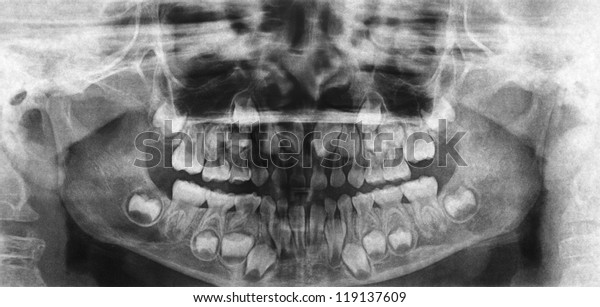Basically what that says is clinically as a dentist we cant see something. Dental radiographs also known as dental X-rays are important diagnostic tools in pediatric dentistry.
 Ninja Economics On Twitter Pediatric Dental X Rays Https T Co Liaycf58j8
Ninja Economics On Twitter Pediatric Dental X Rays Https T Co Liaycf58j8
How safe are Dental X-rays.

Pediatric dental x ray. This will provide an image resembling a periapical radiograph from canine to canine. The x-ray beam is angled in such a way to provide a clear picture of the sides of the teeth. X-Rays for Children As a parent exposing your toddler or child to radiation from an X-ray is never your first choice.
For an occlusal X-ray of the mandibular anteriors position the child as described above but aim the X-ray beam at a 45 upward angle through the tip of the chin. Pediatric Dental X-rays Radiography Children Dental Care Dental Topics In addition to compiling a thorough medical and dental history of a child by performing an in-depth clinical examination Pediatric Dentists often use Dental Radiographs or x-rays for purposes diagnostic and preventative dentistry. While visual inspection with an explorer dental tool can identify surface decay taking an x-ray is the only way to detect inter-proximal cavities or cavities in between the teeth.
Childrens x-rays are recommended based on a need basis. Pediatric Dental X-rays Radiography and Safety X-rays are used in pediatric dentistry for a number of reasons. The FDA defines the pediatric population as birth through 21 years old.
Dental x-rays also help the pediatric dentist ascertain the amount of space in the mouth available for permanent teeth which have not yet erupted as well as determine if the primary teeth are being lost expeditiously enough for the permanent teeth to correctly erupt. Pediatric dental X-rays are detailed images of the interior of teeth and gums. Because our practice is dedicated to providing your child with the safest and most convenient treatment options available.
X-rays can benefit young patients a lot. X-ray films detect much more than cavities. For example X-rays may be needed to survey erupting teeth diagnose bone diseases evaluate.
Radiography also known as the conventional X-ray is the particular type of medical imaging process used in pediatric dentistry which means a single image is recorded for subsequent evaluation. Also an digital x-rays can tell the pediatric dentist how much of the decay has spread within the tooth and if the tooth needs a root canal or a simple filling. We need x-rays to see what is going.
2 For the posterior teeth the oblique occlusal technique can be very helpful. For example spaces in between teeth teeth that are close together. However the optimization of image quality and radiation dose in X-ray imaging depends more on a patients size than their.
These issues would be difficult in some cases impossible to see with the naked eye during a clinical examination. GET ACCESS TO ALL PREMIUM CONTENT WITH NO ADS FOR 499MONTH Watch Later. The use of X-rays in pediatric dentistry helps pediatric dentists discover any oral issue in a childs mouth.
The American Academy of Pediatric Dentistry AAPD intends these recommendations to help practitioners make clinical decisions concerning appropriate selection of dental radiographs as part of an oral evaluation of infants children adolescents and individuals with special health care needs. With contemporary safeguards like lead aprons high speed film digital X-rays thyroid collars the amount of radiation received in a dental X-ray is extremely low. Dental radiographs allow the dentist to see and treat problems like childhood cavities tooth decay orthodontic misalignment bone injuries and bone diseases before they worsen.
The American Academy of Pediatric Dentistry states that pediatric dentists are particularly careful to minimize the exposure of child patients to radiationthe amount of radiation received in a dental X-ray examination is extremely small They even say that the radiation is less harmful than untreated dental problems To put it into perspective of how small the amount is you. Dental radiographs also known as dental X-rays are important diagnostic tools in pediatric dentistry. X-rays allow us to view the hard to see areas of teeth such as around the root of the tooth inside the gums and the jaw.
The term bitewing refers to the method of taking the x ray where the film or digital sensor has a tab or wing attached to it that the patient bites on to secure the film or sensor in place. Pediatric dentists are particularly careful to minimize the exposure of child patients to radiation. Since they allow for a clear picture of the childs teeth teeth roots and jaw pediatric dental X-rays are effective in preventive dentistry.
Dental X-rays and Safety. X-rays act as a second form of an examination as they provide the pediatric dentist with. Children with a low risk of tooth decay require X-rays less frequently.
Dental radiographs allow the dentist to see and treat problems like childhood cavities tooth decay orthodontic misalignment bone injuries and bone diseases before they worsen. Additionally dental x-rays allow the dentist to see if all adult teeth are present below the gum line if extra teeth exist. Pediatric Digital X-rays Using the most advanced dental technology is just as important as staying up to date on the latest treatment techniques.
But X-rays can be valuable diagnostic tools and your childs dentist might recommend that your child get an X-ray done to diagnose any dental. The main benefit of X-rays for children is that it allows the pediatric dentist the chance to take any necessary preventive measures. For children with a high risk of tooth decay the American Academy of Pediatric Dentistry recommends X-ray examinations every six months to detect cavities developing between the teeth.
